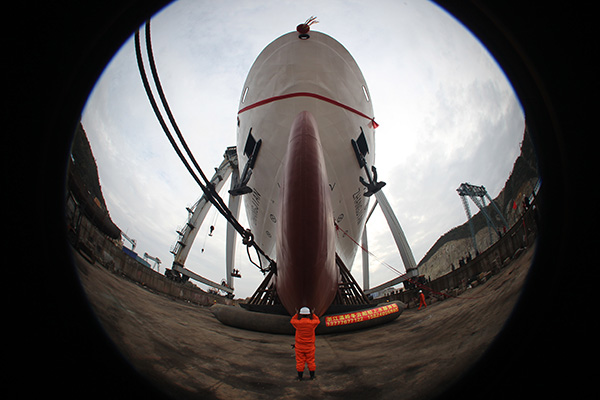
Zhang Jian, China’s first privately funded scientific research ship, is launched in Wenling, Zhejiang province, on March 24, 2016. [Photo/China Daily]
China launched the country’s first ship specifically designed for carrying deep submersibles on March 24, according to Shanghai Ocean University.
The ship, Zhang Jian, named after the founder of the university, is 97 meters long and 17.8 meters wide. It is designed to carry 60 people and has a 15,000-nautical mile range, according to a report on the university’s website.
Its first scientific expedition is planned for August in the New Britain Trench off Papua New Guinea.
The ship will control Rainbow Fish, China’s first 11,000-meter robotic submersible, to try to get 8,000 meters under the surface, said Cui Weicheng of the Hadal Science and Technology Research Center at Shanghai Ocean University.
Cui said the robotic submersible had been tested down to 4,000 meters underwater. If the test in New Britain Trench succeeds, Zhang Jian will take the Rainbow Fish for another dive to 11,000 meters in the Mariana Trench by the end of 2016.
His research center has been working on a new manned submersible that will hopefully be able to take people down to 11,000 meters by 2020.
The current Chinese manned diving record was made by Jiaolong, which reached 7,062 meters in the Mariana Trench in June 2012.
Over the next five years, Chinese scientists plan to build one manned and one unmanned submersible, each of which can reach depths of 11,000 meters.
Cui said Zhang Jian and Rainbow Fish are not included in the government’s 13th Five-Year Plan (2016-20) as they are supported by private investment.
“Zhang Jian is China’s first scientific research ship that was totally financed by the private sector,” Cui said, adding that compared with applying for official finance support, cooperating with the private sectors has shortened the process by four to five years.
“The government and society in China are paying close attention to maritime research more than ever before,” he said. “The golden period for deep-sea technology and exploration has come.”
